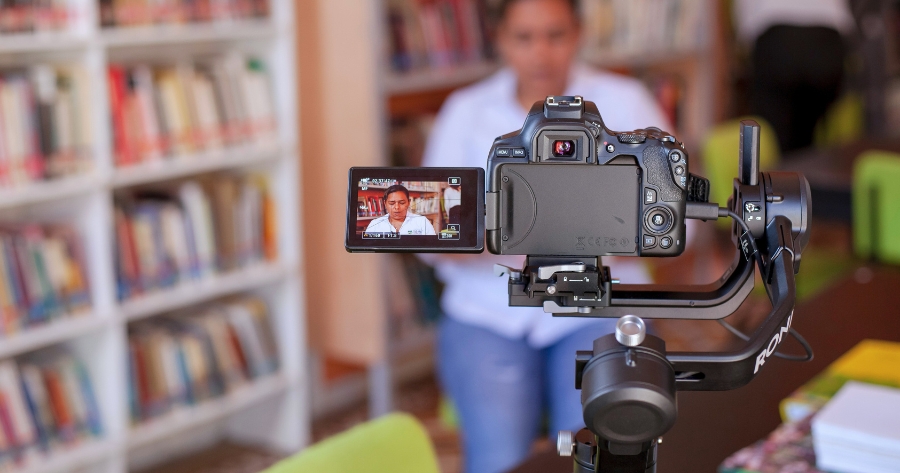Video interviews are one of the most effective ways to capture authentic stories for school social media. Whether you’re highlighting a student project, recognizing a staff member, or capturing a behind-the-scenes moment, an on-camera interview brings the story to life with personality and voice.
The best part? You don’t need fancy gear to do it well. With a little preparation and a few smart techniques, you can make your school’s interviews look and sound great using just a phone or camera, a microphone, and a quiet corner of campus. Here are a few quick tips to capture better video interviews.
1. Capture steady visuals.
Use a phone or camera—whichever you have on hand. Just make sure you can keep it steady. If you’ve got a tripod, great. But if not, master the human tripod stance. With your feet shoulder-width apart, tuck your elbows into your sides and hold your phone with both hands, using your thumbs to stabilize it. This reduces shake and helps you get a clean, clear shot.
2. Use a microphone for clear audio.
If your audience can’t hear the interview, they’ll scroll right past. Use a wired or wireless lapel mic if you have one. Make sure the mic is positioned close to your subject and is compatible with your device. Even earbuds with a built-in mic are better than relying on your phone’s speaker from several feet away.
3. Frame your subject with purpose.
Think beyond “point and shoot.” Use the rule of thirds—instead of placing your subject directly in the center, shift them slightly to one side to create visual depth. Frame them from at least the waist up, leaving a bit of space above their head. Be careful not to cut them off at their shoulders or head.
4. Think ahead about the format.
Are you filming for Instagram Reels or TikTok? Go vertical. Sharing on YouTube or your website? Horizontal might be best. Want to use the footage for both? Record from a little farther back so you can crop it into different formats later without losing quality or framing.
5. Find a quiet spot to record.
Clean audio starts with a quiet setting. Avoid echoey rooms, running HVAC systems, or noisy hallways. Even if the lighting isn’t perfect, audio is harder to fix in post-production than video, so prioritize the environment over lighting when you have to choose.
6. Use natural light when possible.
Natural light is the best and easiest lighting you can use. Face your subject toward the window or light source—never with the light (or sun) behind them. If you’re inside, flip on a few lights to reduce shadows. Outside settings can work great too, as long as you’ve found a quiet spot with soft, even lighting. Overcast days are great for video; do your best to avoid harsh midday sun.
7. Keep the background simple.
The background shouldn’t steal the show. Choose a space that’s simple and distraction-free. If the setting is tied to the story, like interviewing a basketball player in the school gym, go for it! Otherwise, aim for neutral walls, soft colors, or spaces that feel tidy and don’t pull your attention.
8. Step away from the wall.
Avoid putting your subject flat against a wall or backdrop. Give them a few feet of space to create separation between them and the background. It adds depth and dimension, and your video will instantly feel more professional, even with a simple setup.
9. Run a 10-second test before hitting record.
Before you jump into your questions, hit record and do a quick test. Listen to the audio, check the lighting, and make sure your subject is framed the way you want. This quick step can save you from reshoots and help you catch small problems before they become big ones.
You don’t need fancy equipment to capture high-quality interviews or tell meaningful school stories. With a little intention and preparation, your video interviews can spotlight the voices that make your school community special—and help you create authentic, human-centered content that truly resonates.
Interested in learning more about how Class Intercom can help your school or district source authentic stories and create engaging content? Our team would love to connect. Follow the link below to get in touch.
